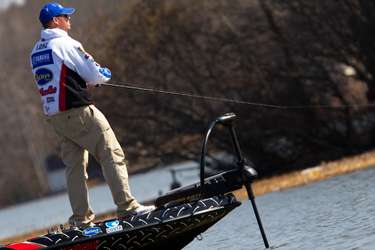
Most years, the first quarter’s conclusion would find Elite Series pro Russ Lane thinking about zipping a spinnerbait at a pretty good clip. However, 2010 has seen a lot of blue in the weather maps, so he’ll be sticking with his strategy of cool season blade adjustments for a bit longer.
“Usually when you have a big spinnerbait, it’s moving pretty fast, but if you increase the size of your blades, you can really slow it down,” the Prattville, Ala., angler said. “Normally, this deal would be ending up right about now, but with the extremely cold winter, the water is remaining so cold, I would think about doing this all the way through early April.”
For mornings that bring air temperatures in the low 40s with the promise of nothing above the low 50s, Lane said there’s only one way to go — slow. That said, he’s devised a trio of spinnerbait configurations to achieve that objective. Each configuration is tied to a specific scenario, as follows:
1. Lakes with flat terrain
Looking for shallow, dirty water (3 feet or less), which warms up quicker than deep, clear water, Lane starts with a 1/2-ounce Buckeye Lures spinnerbait, adds a No. 3 1/2 Colorado blade in front and rigs a No. 7 Indiana blade in back.
“That Indiana blade is a 2-inch blade, so it moves a tremendous amount of water, and that allows you to move that bait in 2 feet of water without getting caught up in the bottom debris,” he said. “That gives those lethargic fish more opportunity to react to the bait.”
Noting that the Indiana blade’s wide cup creates more “lift,” Lane said he prefers 20-pound Berkley Trilene Big Game monofilament because of the line’s buoyancy. In really shallow water, holding the rod at 10 o’clock helps keep the bait high.
2. Prespawn fish in natural creeks
Arteries with distinct channels that swing back and forth and touch the banks are Lane’s preference. Here, he’ll go with a 3/4-ounce Buckeye Lures spinnerbait with a No. 3 Colorado blade on the front and a No. 7 willow leaf blade in back.
“That willow leaf blade is a long blade — about 4 inches long — but it has a narrower cup than the Indiana blade, so it allows you to get the bait deeper but still keep it moving slowly,” Lane said. “Also, that heavier head allows you to get that bait down in [depths up to] 8 feet.”
Lane said that this scenario is one in which most anglers are more likely to throw a shallow running crankbait; however, he believes he can fish behind other anglers with a different presentation that triggers bites — often big ones — in used water.
Using 17-pound Berkley 100% Fluorocarbon to facilitate a faster fall, Lane keeps his rod at 8 or 9 o’clock for this presentation.
“The whole key to this scenario is keeping the bait on the bottom and keeping those blades turning.”
3. Clear water reservoirs
On lakes such as Alabama’s Martin or Missouri’s Table Rock, Lane looks for transitional banks (e.g., pea gravel merging with larger rock) in 8 to 10 feet and throws a 3/4-ounce Buckeye Lures spinnerbait with a 1/4-ounce rubber core sinker cinched onto the hook shank. This bait carries a lone No. 6 willow blade.
“That gives you a total weight of 1 ounce, but it keeps a smaller profile on the bait, as opposed to the larger profile of (an actual) 1-ounce spinnerbait,” he said. “That (willow) is still a big blade, which allows you to fish really slowly, but it still has a lot of drag and allows you to stay in contact with the bottom.”
Lane fishes this bait on 15- to 17-pound Berkley 100% Fluorocarbon. Forcing his rod tip down ensures the lower angle he needs to keep the bait running deep.
For all applications, Lane fishes spinnerbaits on a 7-foot medium-heavy American Rodsmiths Team Series rod with an Abu Garcia Revo 6.3:1 baitcaster. He adds a Big Bite single tail grub to each of these configurations for more lift and matches the trailer to his skirt, and that’s usually a pearl color. Blade color depends on water clarity.
“Unless it’s extremely muddy, I almost always have a gold blade in front and silver in back,” Lane said. “If the visibility is a foot or less, then I’ll go with all gold blades.”
Now, once official spring patterns take hold, Lane will step on the gas with his spinnerbaits. When the third quarter rolls around, he’ll again ride the brake with big blades.
“This works anytime that you feel the fish are in a lethargic mood and you want to throw a large profile bait, but you don’t want it moving too fast.”





